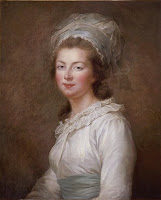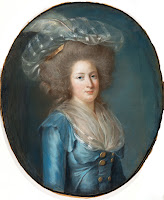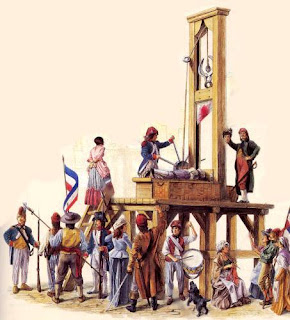Princess Elisabeth, Faithful Sister of Louis XVI
On this day in 1764, Élisabeth-Phippine-Marie-Hélène de France, daughter of the Dauphin Louis, son of Louis XV, and Marie-Josèphe de Saxe, was born at Versailles.
Grandaughter of the King of France. Daughter of the Dauphin of France. Sister of King Louis XVI and beloved friend and sister-in-law of Marie Antoinette.
Although her ancestry is impressive, she is known more for her impeccable behavior and unmatched loyalty (as you will soon learn).
Much has been written about Princess Élisabeth. Every Marie Antoinette blog on the internet offers a biography about this brave, loyal woman, so out of deep respect for you, my learned and treasured reader, I have resisted the urge to regurgitate the more mundane points of her life. Instead, I ventured into my archives and unearthed a few rare tidbits about this fabulous princess.
Tidbits about Princess Élisabeth of France:
*Postscript ~ My dear friend and fellow member of Marie Antoinette's coterie, Madame Guillotine, sent me an email alerting me of her recent post on Madame Élisabeth. It's a very lovely tribute, so please do pop over and take a look, won't you?
 |
| Élisabeth by Vigee-Lebrun |
Grandaughter of the King of France. Daughter of the Dauphin of France. Sister of King Louis XVI and beloved friend and sister-in-law of Marie Antoinette.
Although her ancestry is impressive, she is known more for her impeccable behavior and unmatched loyalty (as you will soon learn).
Much has been written about Princess Élisabeth. Every Marie Antoinette blog on the internet offers a biography about this brave, loyal woman, so out of deep respect for you, my learned and treasured reader, I have resisted the urge to regurgitate the more mundane points of her life. Instead, I ventured into my archives and unearthed a few rare tidbits about this fabulous princess.
Tidbits about Princess Élisabeth of France:

- Like many women of her era, Élisabeth enjoyed reading and letter writing. This rosewood and bronze desk was made by the sought-after ébéniste Guillaume Benneman for Élisabeth's private apartments at the Château de Compiègne. The sides are of inlaid wood. Today, it resides at Versailles and is sometimes displayed in the rooms of the Petit Trianon or in the King's Apartments in the palace.
- If you would like to read the Life and Letters of Madame Élisabeth, click here.
- The King's sister was known for her piety and charity.
- Marie Antoinette asked Élisabeth to look after Madame Royale's religious and moral upbringing. Later in her life, Marie Antoinette's daughter was often praised for her strength and admirable character. Élisabeth deserves some of the credit in the development of her niece's fortitude and attitude.
- Louis Charles (Élisabeth's nephew) was a rather active boy (today we might describe him as having ADHD). The restless, active boy found it difficult to settle down at night and fall asleep. Often, Élisabeth would hold her nephew while Marie Antoinette played lullabies on her harp. (Would you like to see a photograph and learn more of Marie Antoinette's harp? Click here)
- Jean-Baptiste Boulard, the talented cabinetmaker who created many splendid pieces for the royal family of France, made this charming chair for Élisabeth's private apartment at the Château de Compiègne.
- Élisabeth was a skilled seamstress who enjoyed doing petit point. The petit point tapestry on this chair was created by the Princess.
- If you would you like to see another one of Élisabeth's chairs, please click here.
- Like her brother Louis, Élisabeth loved horses and was an accomplished rider.
- Élisabeth was a skilled drawer. Several of her drawings are on display at Versailles.
- Also like her brother, Élisabeth enjoyed working with her hands. As I already mentioned, she enjoyed embroidery. She also owned a printing press and enjoyed working on it.
- Devoted to her brother and country, she refused to marry, preferring to stay in France.
- Recognizing his sister's private nature, Louis XVI gave Élisabeth a charming country estate on the outskirts of Paris. This home was called Montreuil and Élisabeth adored it.
- Montreuil had a dairy. Élisabeth donated the milk from her dairy to a local foundling hospital.
- If you would like to learn more about Montreuil, please read Elena Maria Vidal's wonderful post on Tea at Trianon.
- Élisabeth was at Montreuil on the 5th of October of 1789, when she received the news that an angry mob was marching on Versailles. She left her home and returned to the palace at once.
- Élisabeth volunteered to accompany her brother, sister-in-law, niece, and nephew to prison.
- When guards searched the cell of Louis XVII (the son of Louis and Antoinette), they found a small embroidered Sacred Heart. The Sacred Heart (a heart pierced by an arrow) was the symbol of the counter-revolutionaries in the Vendee. Princess Elisabeth gave her nephew the Sacred Heart.
- For the Flight to Varennes, the royal family's ill-fated escape attempt, Elisabeth dressed as a nurse.
- Born of a delicate nature, Elisabeth suffered from fainting fits. These fits increased near the end of her life, exacerbated, no doubt, by the enormous stress of being imprisoned by brutal guards and threatened daily with death.
- After being sentenced to death, Marie Antoinette returned to her room in the Conciergerie, wept copious tears, and wrote a last letter to Elisabeth. She confided her children to her sister-in-law.
- Although Robespierre never considered Élisabeth a threat, she was eventually brought to trial and found guilty of having assisted the King in his attempt to escape (Flight to Varennes). She was sentenced to death by guillotine.
- Élisabeth died on May 10, 1794.
- 22 other souls lost their lives at the guillotine that day.
 |
| Montreuil |
 |
| Sacred Heart |
 |
| Antoinette's last letter to Elisabeth |
 |
| Élisabeth |
- Élisabeth's body was thrown in a common grave in the Cimetière des Errancis in Paris. The cemetary was used for victims of the guillotine but no longer exists.
- Madame Royale considered her Aunt Élisabeth to be her second mother. Madame Royale wrote of her aunt, "I feel I have her nature . . . [she] considered me and cared for me as her daughter, and I, I honoured her as a second mother." (Marie-Thérèse: The Fate of Marie Antoinette's Daughter by Sophie Nagel, page 144)
- Madame Royale mourned her aunt's passing for the rest of her life. She kept the dear woman's portrait near her at all times.
- As she grew into adulthood, Madame Royale, Marie Antoinette's daughter, was often told she resembled her Aunt Élisabeth.
*Postscript ~ My dear friend and fellow member of Marie Antoinette's coterie, Madame Guillotine, sent me an email alerting me of her recent post on Madame Élisabeth. It's a very lovely tribute, so please do pop over and take a look, won't you?



Thank you for this. I admire Madame Elisabeth very much. Here is a post of my own about her; her distant relative Princess Henriette of Belgium worked for Elisabeth's cause of beatification and wrote a lovely biography of her:
ReplyDeletehttp://crossoflaeken.blogspot.com/2010/06/elisabeth-and-henriette.html
Dear Matterhorn:
ReplyDeleteThank you for visiting my blog and for leaving a link to your article. I am on my way now...
It is interesting that she was not really mentioned in the Biography that led to the 2006 Marie Antoinette bio pic. Thanks!
ReplyDeleteI like your blog!
ReplyDeleteI am doing geneaology and have found a relative that was first maid to Elisabeth of France in 1782.
What were the duties of the first maid?
Are there any references you could link me to?